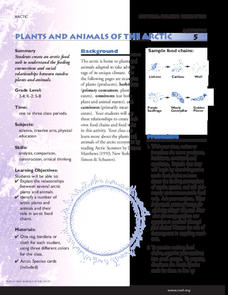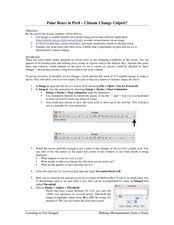Core Knowledge Foundation
Animals and Habitats Tell It Again!™ Read-Aloud Anthology
A read-aloud anthology explores various habitats and the animals that inhabit them, from the Artic to the desert, the forest, and bodies of water. First graders listen to and discuss texts and complete word work. Each lesson offers...
Consortium for Ocean Science Exploration and Engagement (COSEE)
Arctic Smorgasbord
Though the walrus spends roughly one third of its time on land, it eats organisms that live on the bottom of the ocean. The first in a series of five, the lesson uses a variety of plant and animal cards to have scholars build an arctic...
Mr. Nussbaum
Penguins
Penguins are the topic of an informational text that scholars read or listen to, then answer 10 multiple-choice questions.
Mr. Nussbaum
Arctic Fox
A short informative text shares details about the Arctic Fox. Scholars read or listen to the text then answer 10 multiple-choice questions.
National Wildlife Federation
Massive Migrations: Grades K-4
Bird migration is a fascinating behavior. Budding scientists experience their own migrations using the school grounds for their flight patterns. They follow a map that leads them through a migration pattern that includes stops for...
National Wildlife Federation
Plants and Animals of the Arctic
The Arctic food web may be more limited than other environments, but it has all the same components. With an interactive activity, pupils assume the roles of the components of an Arctic food chain. They move around and link themselves to...
Science Matters
Formative Assessment #2
Learners work collaboratively to predict what life would be like as an Arctic Hare. Teams go on a hunt where scholars role play an owl, white hares, and gray hares. Independently, pupils record their findings and reflect on their...
NOAA
Please Pass the Salt
Salinity is the focus of two experimenters that work to answer the question, How does salt change the physical properties of water? Super scientists compare the freezing rate of salt and fresh water, combine the two waters to...
Wildlife Conservation Society
Build Your Wild Self
Get wild with an interactive web site that challenges scholars to create their wildest self. Future wild things begin as an average person—eyes, mouth, clothes—then morph into animal attributes—horns, tails, wings—and end in the...
Chicago Botanic Garden
Food for Thought: Climate Change and Trophic Cascades
Learners examines the arctic food web with a short video about polar bears and an article about bears and warming temperatures. They design an arctic food web and discuss the trophic cascade that could come from climate...
A to Z Teacher Stuff
Word Search Match
Go beyond a traditional word search with a clue matching, word search combo. Scholars read clues, write the word that matches, then search for the word in a puzzle. Clues and words offer insight into the life of polar bears.
A to Z Teacher Stuff
Polar Bear Crossword
Show what you know about polar bears with a 10-question crossword puzzle. Questions pertain to a polar bears' habitat, food source, and more!
Wild BC
Bearly Any Ice
After reviewing food chains, your class members participate in an arctic predator-prey game that exemplifies the impact of climate change of food availability. If you are in a hurry, skip this lesson, but if you have the time to...
Curated OER
Polar Bears
What do you know about polar bears? Get your youngsters writing about these majestic animals with this short writing activity. They simply use the six words provided to create a short story about the picture provided. Review the words...
Curated OER
Bears
The Grizzly, Polar, and Panda are all types of bears; they are also the topic of this informative presentation. Each slide contains numerous facts about bear habitats, food resources, and characteristics. Fun photographs, sound, and...
Curated OER
Polar Bears in Peril - Climate Change Culprit?
Students explore the changes in sea ice over several years. In this life science lesson, students review and examine 20 years of data. They use Excel to graph data and analyze trends.
Curated OER
Blubber Mittens:Adaptation to Cold Climates
Learners get a first hand look at the benefit of a "blubber layer" in cold climates through a simulation using vegetable shortening and icy water. Through this simulation, students examine how adaptations help organisms survive.
Curated OER
Animal Survival
Viewers of this PowerPoint are introduced to endangered and extinct animals. They discover why apes, elephants, pandas, polar bears, rhinoceri, and marine turtles are threatened. Finally, ways that humans have and can make a difference...
Curated OER
Adaptation
The camel, polar bear, penguin, golden eagle, shark, and ostrich are displayed as examples of animal that have adapted to their particular environments. Each slide has a picture of the animal and a bullet-style list of the animal's...
Curated OER
Life in the Freezer
For this global warming worksheet, climatologists examine a few possible results of climate change. There is no specific reading from which learners extrapolate the information needed to answer the questions, so you will need to preface...
Curated OER
Researching Polar Animals
Second graders read the questions about polar animals and use the Internet to perform a search for the answers to the questions. They click on the blue links to go to the particular website with the answers and then print off their sheet.
Curated OER
Why Polar Bears Are White
Students are introduced to the concept of camouflage and protective coloration as well as Arctic animals. They examine how color can help animals in the wild. Students discuss where polar bears live and why they are white.
Curated OER
Global Warming
First graders discover the effects of global warming on polar bears. In this life science lesson, 1st graders model the polar bear's habitat and observe what happens as they raise the temperature. They record their observation in the...
Curated OER
Fact
Young scholars read about polar bears and discuss and identify the facts they learn about them. In this facts lesson plan, students explain why their facts are not opinions.

























